
Original Link: https://www.anandtech.com/show/2570
Kingwin RVT-9225: Budget priced cooling results in budget performance
by Matt Campbell on July 16, 2008 2:00 AM EST- Posted in
- Cases/Cooling/PSUs
Introduction
In our CPU Cooler review in March, the Noctua NH-U12P emerged as one of the best cooling performers we've tested here at AnandTech. However, at a price point of around $90 with two fans, that performance doesn't come cheap. Today we're going to look at a less expensive alternative, the Kingwin RVT-9225.
KWI Technology Inc., known as Kingwin, sells a number of PC components besides CPU coolers, including power supplies, fans, cables, and so forth. Their CPU cooler line has three recent models supporting modern processors; these are all part of the Revolution line, which consists of the RVT-9225, the RVT-12025, and the RVT-12025D. All of these incorporate "H.D.T." as they term it, Heatpipe Direct Touch, which essentially describes what it is: the heatpipes actually run through the CPU block and have a large contact surface to the CPU.
As we'll see, this is effectively marketing hype and does not provide performance gains over other approaches. The RVT-9225 is the smallest of the bunch, with a 92mm x 25mm fan (hence the name), and retails at Newegg for around $30.

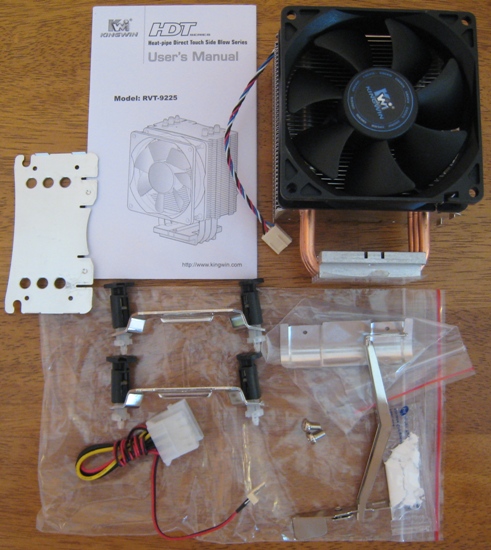
Specifications
| Kingwin RVT-9225 Heatsink | |
| Dimensions | 3.63" x 5.27 x 1.97" /92(L) x 134(H) x 50(W) mm |
| Weight | 0.91Lbs / 410 g (w/fan) |
| Material | Aluminum w/ copper base |
| Fan Configuration | Single 92mm fan, rubber mounts |
| Kingwin RVT-9225 Fan | |
| Model | Kingwin Revolution RVT-9225 |
| Fan Size | 92 x 92 x 25 mm PWM |
| Bearing Type | Rifle bearing |
| Noise Level | 23~35 dBA |
| Speed | 1200~2800 RPM |
| Air Flow | 39~54.6 CFM |
| Voltage Range | 12V |
| Fan Life | 50,000 hrs |
| Connector | 4 Pin with PWM |
Installation
Kingwin provides reasonably clear instructions in the box, though their pictures could be better. Thankfully, due to the relatively light weight of the cooler, this is an easy installation using the LGA775 push pins; there is no need to remove the motherboard. Step 1 is to remove the plastic film protecting the CPU mating surface - skipping this step would be bad.
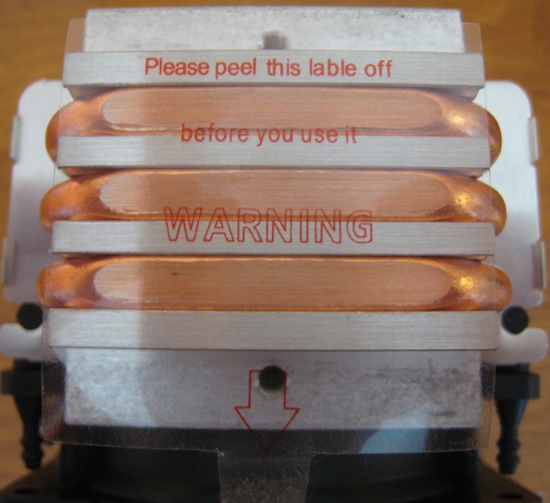
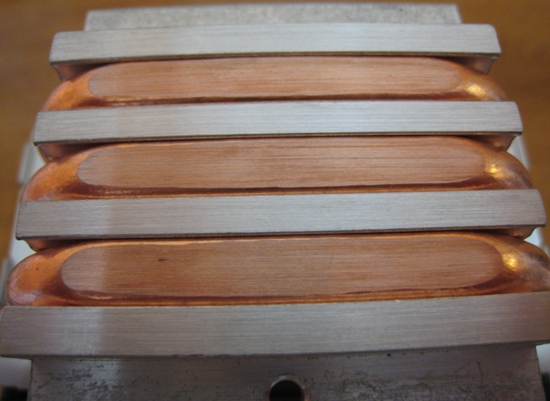
Next, attach your legs, insert the air "spoiler" (yes, it really does have one), apply thermal grease, and you're ready to mount.
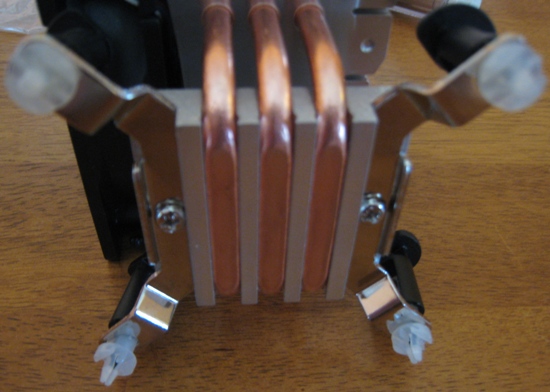
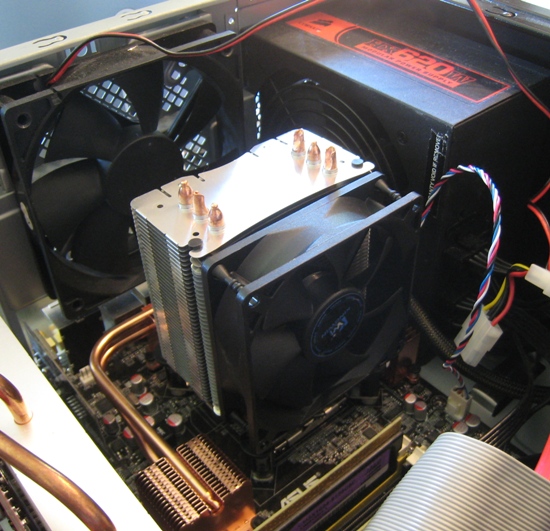
As you can tell both from the weight and from the picture, this is considerably smaller than other heatpipe coolers like the Noctua and Tuniq.
Test Configuration
As we've covered test configuration in detail in the past, we won't belabor it here. Our test bed remains the same as it was in March: a Rosewill R604-P-SL case with a Corsair HS620W power supply and a fanless motherboard/video card combination to eliminate stray noise sources.
| Cooling Performance Test Configuration | |
| Processor | Intel Core 2 Duo X6800 (Dual-core 2.93GHz, 4MB Unified Cache) |
| RAM | 2x1GB Corsair Dominator PC2-8888 (DDR2-1111) |
| Hard Drive(s) | Hitachi 250GB SATA2 enabled (16MB Buffer) |
| Video Card | MSI NX8600GTS (fanless) - All Standard Tests |
| Intel TAT | Version 2.05.2006.0427 |
| CoreTemp | Version 0.95 |
| Video Drivers | NVIDIA 163.71 |
| CPU Cooling | Kingwin Revolution RVT-9225 Noctua NH-U12P Arctic Cooling Alpine 7 (with PWM) Arctic Cooling Freezer Pro 7 ZEROtherm Nirvana NV 120 Cooler Master Hyper 212 OCZ Vendetta Scythe Kama Cross Swiftech H2O-120 Compact Corsair Nautilus 500 Thermalright Ultima-90 ZEROtherm BTF90 Xigmatek AIO (AIO-S800P) Evercool Silver Knight Enzotech Ultra-X 3RSystem iCEAGE Thermaltake Big Typhoon VX Thermaltake MaxOrb Scythe Andy Samurai Master Cooler Master Gemini II Noctua NH-U12F Asus Silent Square Pro Scythe Ninja Plus Rev. B OCZ Vindicator Thermalright Ultra 120 Extreme Thermalright Ultra 120 Scythe Infinity Zalman CNS9700 Zalman CNS9500 Cooler Master Hyper 6+ Vigor Monsoon II Lite Thermalright MST-9775 Scythe Katana Tuniq Tower 120 Intel Stock HSF for X6800 |
| Power Supply | Corsair HX620W |
| Motherboards | Asus P5K Deluxe (Intel P35) |
| Operating System | Windows XP Professional SP2 |
| BIOS | Asus AMI 0501 (06/26/2007) |
Room temperature is maintained at 74°F (23°C) throughout testing. We are still using the Far Cry River demo as our benchmark for the purpose of consistency, and thus we can include historical results for reference. CoreTemp is used for temperature monitoring.
Cooling at Stock Speed
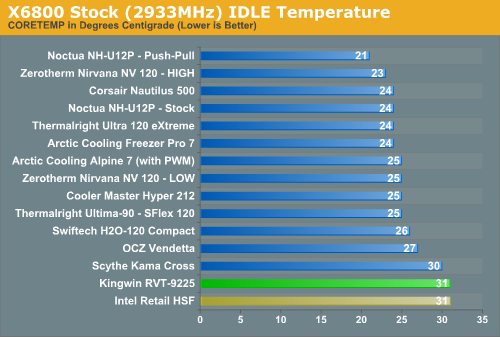
Performance at stock speed (2.93GHz) with the RVT-9225 is exactly as measured with the Intel retail unit. While the stock unit is quite decent, we expected to see a small improvement here. However, it's under load conditions that an upgraded heatsink/fan unit should make a big difference. Load conditions are measured through looping the Far Cry River demo and logging temperature results. The highest sustained temperature is recorded.
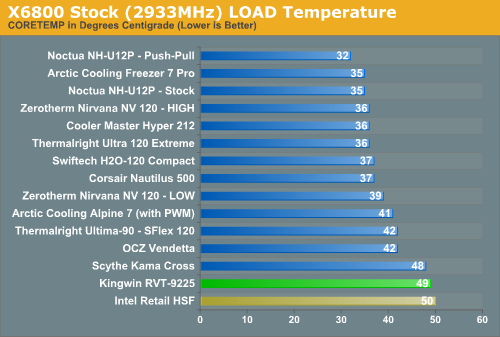
Once again, the performance of the RVT-9225 is almost exactly that of the Intel unit. Unless it can distance itself in some manner, the RVT-9225 will clearly lose to the "free" cooler.
Noise Levels
Noise levels are measured using a sound meter at distances of 6" and 24". The ambient noise level was measured at 38.3 dB(A).
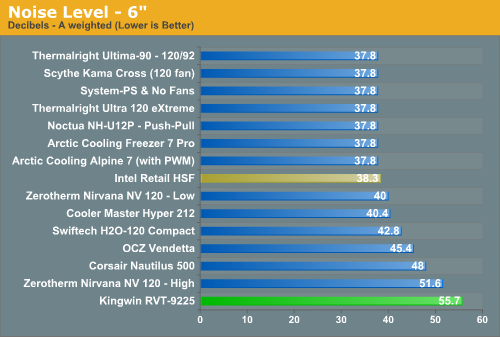
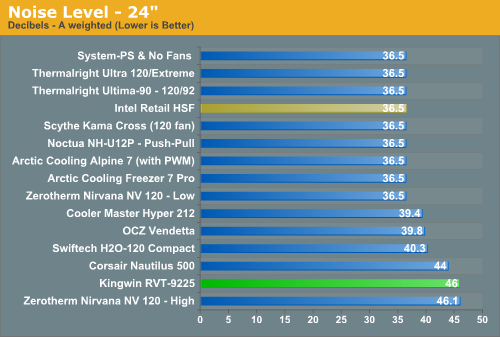
This unit is quite loud, partially due to the 92mm fan (as opposed to 120mm on many recent models). The noise is not high pitched or overly irritating, but it is a steady drone that could even be heard from the next room with the door open.
So far, the RVT-9225 hasn't bettered the performance of the stock retail Intel cooler, but it is significantly louder than that counterpart. Unless it can pull out a win in overclocking, things are looking grim for the RVT-9225.
Overclocking
Some users buy aftermarket coolers to quiet down their system, but many are seeking performance gains in the area of overclocking. In the days of shoddy Intel HSFs, a quality aftermarket cooler could equal double-digit percentage gains. As we've mentioned previously, Intel's current incarnation is quite good, but gains can still be significant. Let's see how the RVT-9225 stacks up. Again, the same processor and settings are used for all cooling tests for consistency.
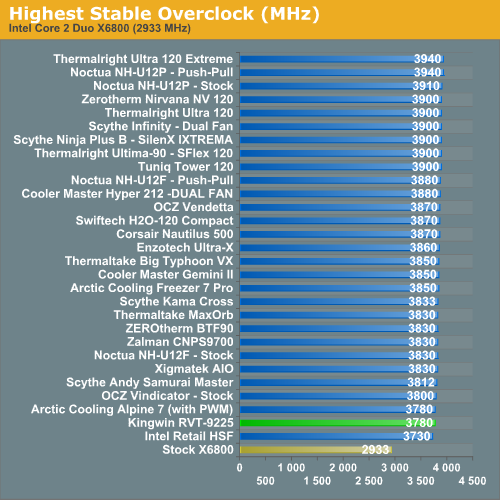
The Kingwin RVT-9225 just barely scrapes a lead over the Intel unit with a maximum stable speed of 3.78GHz. This is disappointing, particularly as the noise level is so much higher than the competing units.
Performance Scaling
Performance scaling is shown below - keep in mind that lower is better in this case. As mentioned the maximum overclocks top out at 3.78GHz, but we file this under "3.83GHz" (rounding up).
 |
Again, we see what seems to be a theme: the RVT-9225 tracks the Intel unit almost exactly. It only ekes out a slight win at 3.33GHz.
Load conditions are a good indicator of cooling performance, and as we've said in the past, a flatter line here is better versus a steep slope (indicating that the cooler cannot effectively handle the load it's being presented with).
 |
There's no real news here. We see almost a mirror image of the Intel retail HSF, with a slight win at 3.33GHz only.
Conclusion
There's not much to say here. We really expected the RVT-9225 to perform better than it did, particularly with a 120mm case fan exhausting the air directly behind it. Overclocking performance is equivalent to a unit half the price (the Alpine 7) at orders of magnitude more noise than that heatsink.
We can't recommend this product over its competitors, and can only hope that the 120mm variants in this line put up more of a fight. Even worse is that we wouldn't even recommend this cooler over the "free" Intel retail cooler. It does post slightly better scores in a few areas, but the noise outweighs the slight wins. Even if you have $30 burning a hole in your pocket, there are clearly better ways to spend it.







